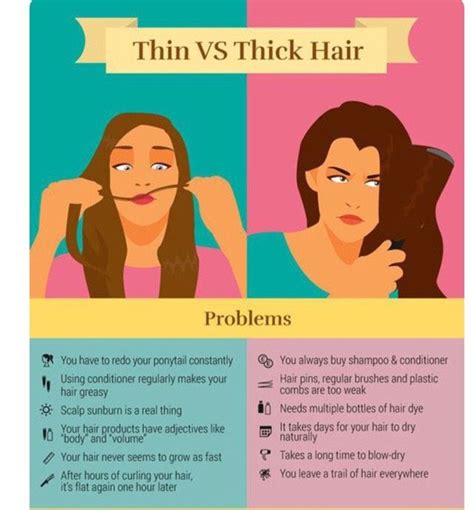What’s the Difference?
Your scalp is the skin that covers your skull. It’s made up of several layers of tissue, including hair follicles, blood vessels, and nerves. The thickness of your scalp can vary from person to person.

Fine Scalp
A fine scalp is thinner than a thick scalp. It has fewer hair follicles and less blood flow. This can make your hair look thinner and less full.
Thick Scalp
A thick scalp is thicker than a fine scalp. It has more hair follicles and more blood flow. This can make your hair look thicker and fuller.
Which is Better?
There is no one “better” type of scalp. Both fine and thick scalps have their own advantages and disadvantages.
Advantages of a Fine Scalp
- Hair is less likely to become oily.
- Hair is easier to style.
- Hair is less likely to break.
Disadvantages of a Fine Scalp
- Hair can look thinner and less full.
- Hair can be more difficult to grow.
- Hair can be more susceptible to damage.
Advantages of a Thick Scalp
- Hair is thicker and fuller.
- Hair is less likely to become oily.
- Hair is less susceptible to damage.
Disadvantages of a Thick Scalp
- Hair can be more difficult to style.
- Hair can be more prone to dandruff.
- Hair can be more difficult to grow.
How to Determine Your Scalp Type
The best way to determine your scalp type is to look at it. If you have a fine scalp, your hair will be thinner and less full. If you have a thick scalp, your hair will be thicker and fuller.
You can also use a simple test to determine your scalp type. Wet your hair and then apply a small amount of conditioner to your scalp. Massage the conditioner into your scalp for a few minutes and then rinse it out. If your hair feels soft and smooth, you have a fine scalp. If your hair feels dry and rough, you have a thick scalp.
How to Care for Your Scalp
The best way to care for your scalp is to use a gentle shampoo and conditioner. Avoid using harsh chemicals or styling products that can irritate your scalp.
You should also wash your hair regularly, but not too often. Washing your hair too often can strip away your scalp’s natural oils, which can lead to dryness and irritation.
Here are some additional tips for caring for your scalp:
- Use a wide-toothed comb to brush your hair. This will help to prevent breakage.
- Avoid using hot styling tools. Heat can damage your hair and scalp.
- Get regular trims. This will help to remove split ends and keep your hair healthy.
- Eat a healthy diet. Eating a healthy diet can help to promote healthy hair growth.
Common Mistakes to Avoid
Here are some common mistakes to avoid when caring for your scalp:
- Using harsh chemicals or styling products.
- Washing your hair too often.
- Using hot styling tools.
- Not getting regular trims.
- Eating a poor diet.
FAQs
Q: What is the best shampoo and conditioner for my scalp type?
A: The best shampoo and conditioner for your scalp type will depend on your individual needs. However, it is generally recommended to use a gentle shampoo and conditioner that is free of harsh chemicals.
Q: How often should I wash my hair?
A: The frequency with which you should wash your hair will depend on your individual needs. However, it is generally recommended to wash your hair 2-3 times per week.
Q: What are the benefits of using a wide-toothed comb?
A: Using a wide-toothed comb can help to prevent breakage. This is because the teeth of a wide-toothed comb are wider apart than the teeth of a regular comb, which means that they are less likely to catch on your hair and pull it out.
Q: Why is it important to get regular trims?
A: Getting regular trims is important because it helps to remove split ends. Split ends can travel up the hair shaft and cause breakage.
Q: What are the best foods for healthy hair growth?
A: There are many foods that can help to promote healthy hair growth, including fruits, vegetables, and whole grains. Some of the best foods for healthy hair growth include spinach, carrots, sweet potatoes, and nuts.
Table 1: Scalp Types
| Scalp Type | Characteristics |
|---|---|
| Fine | Thin, less full, fewer hair follicles |
| Thick | Thick, fuller, more hair follicles |
Table 2: Scalp Care Tips
| Tip | Description |
|---|---|
| Use a gentle shampoo and conditioner | Avoid harsh chemicals or styling products |
| Wash your hair regularly | 2-3 times per week |
| Use a wide-toothed comb | Prevent breakage |
| Avoid using hot styling tools | Heat can damage your hair and scalp |
| Get regular trims | Remove split ends |
Table 3: Common Mistakes to Avoid
| Mistake | Description |
|---|---|
| Using harsh chemicals or styling products | Can irritate your scalp |
| Washing your hair too often | Can strip away your scalp’s natural oils |
| Using hot styling tools | Can damage your hair and scalp |
| Not getting regular trims | Can lead to split ends and breakage |
Table 4: Benefits of Eating a Healthy Diet
| Benefit | Description |
|---|---|
| Promotes healthy hair growth | Certain foods are rich in nutrients that are essential for healthy hair growth |
| Prevents hair loss | A healthy diet can help to prevent hair loss by providing your body with the nutrients it needs to produce hair |
| Improves the appearance of your hair | Eating a healthy diet can help to make your hair look healthier, shinier, and fuller |
